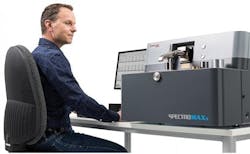SPECTROMAXx LMX10 ARC/SPARK OES Analyzer
The SPECTROMAXx LMX10 ARC/SPARK OES Analyzer enables fast, accurate, advanced elemental analysis in metal producing and fabricating plants and iron and non-ferrous foundries. It delivers repeatability, reproducibility, and reliability in material control analyses from incoming materials to in-process testing to final quality inspections.
In addition, the analyzer features SPECTRO’s proprietary iCAL 2.0 calibration logic, which requires only 5 minutes and a single sample per day, and it automatically compensates for most changes in environmental temperature or pressure. Users can obtain ultrafast information on changing process conditions while achieving drastically reduced cost of ownership with lower consumables. Advanced diagnostics and easy maintenance prevent expensive downtime.
The tenth generation introduces many new advancements that meet industry’s ever-evolving requirements, including: new analytical performances, new argon cost savings, increased ease of use, and SPECTRO’s SPARK ANALYZER Pro software.
The new SPECTROMAXx LMX10 ARC/SPARK OES analyzer is available in two models. The basic SPECTROMAXx features a single air optic with state-of-the-art CMOS sensors proven in the flagship SPECTROLAB S. It extends the relevant and applicable elemental wavelength range from 0.000009 to 0.000026 in. (233 to 670 nm). In addition, a new option analyzes relevant wavelengths to 0.00003 in. (766 nm), covering potassium.
The SPECTROMAXx Advanced utilizes the same high-resolution CMOS technology, with the air optic covering the same wavelengths as the basic model. An added UV optic handles a lower spectral range, from 0.0000047 to 0.000009 in. (120 to 235 nm). This includes a new capability to analyze oxygen in copper.
- Unique iCAL 2.0 one sample standardization helps maintain the same standardization — regardless of most temperature shifts and saves on average 30 minutes per day
- 30% to 40% improved detection limits compared to its predecessor (example: iron, aluminum, and copper base)
- Up to 64% reduced argon consumption during standby compared to previous models
- Ideal for routine analysis and precise analysis of all incoming/outgoing materials and for process control (including nitrogen) in foundries — covering 10 matrices, 65 methods, and 59 elements
